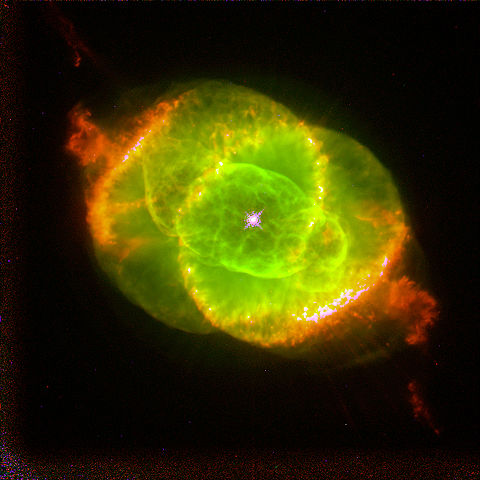
File:The Cat's Eye Nebula - GPN-2000-000955.jpg

| |
This is a file from the Wikimedia Commons. Information from its description page there is shown below.
Commons is a freely licensed media file repository. You can help. |
| Description |
English: This NASA Hubble Space Telescope image shows one of the most complex planetary nebulae ever seen, NGC 6543, nicknamed the "Cat's Eye Nebula."
Hubble reveals surprisingly intricate structures including concentric gas shells, jets of high-speed gas and unusual shock-induced knots of gas. Estimated to be 1,000 years old, the nebula is a visual "fossil record" of the dynamics and late evolution of a dying star. A preliminary interpretation suggests that the star might be a double-star system. The suspected companion star also might be responsible for a pair of high-speed jets of gas that lie at right angles to this equatorial ring. If the companion were pulling in material from a neighboring star, jets escaping along the companion's rotation axis could be produced. These jets would explain several puzzling features along the periphery of the gas lobes. Like a stream of water hitting a sand pile, the jets compress gas ahead of them, creating the "curlicue" features and bright arcs near the outer edge of the lobes. The twin jets are now pointing in different directions than these features. This suggests the jets are wobbling, or precessing, and turning on and off episodically. This colour picture, taken with the Wide Field Planetary Camera-2, is a composite of three images taken at different wavelengths. (red, hydrogen-alpha; blue, neutral oxygen, 6300 angstroms; green, ionized nitrogen, 6584 angstroms). The image was taken on September 18, 1994. NGC 6543 is 3,000 light-years away in the northern constellation Draco. The term planetary nebula is a misnomer; dying stars create these cocoons when they lose outer layers of gas. The process has nothing to do with planet formation, which is predicted to happen early in a star's life. |
||||||
| Date | 18 September 1994 | ||||||
| Source | Great Images in NASA Description | ||||||
| Author | NASA J.P.Harrington and K.J.Borkowski University of Maryland | ||||||
| Permission ( Reusing this file) |
|
| This image or video was catalogued by Hubble Space Telescope Institute of the United States National Aeronautics and Space Administration (NASA) under Photo ID: GPN-2000-000955 AND Alternate ID: PRC95-01A. This tag does not indicate the copyright status of the attached work. A normal copyright tag is still required. See Commons:Licensing for more information. |
File usage
More information
All five editions of Schools Wikipedia were compiled by SOS Childrens Villages. SOS Children's Villages helps more than 2 million people across 133 countries around the world. Learn more about child sponsorship.



